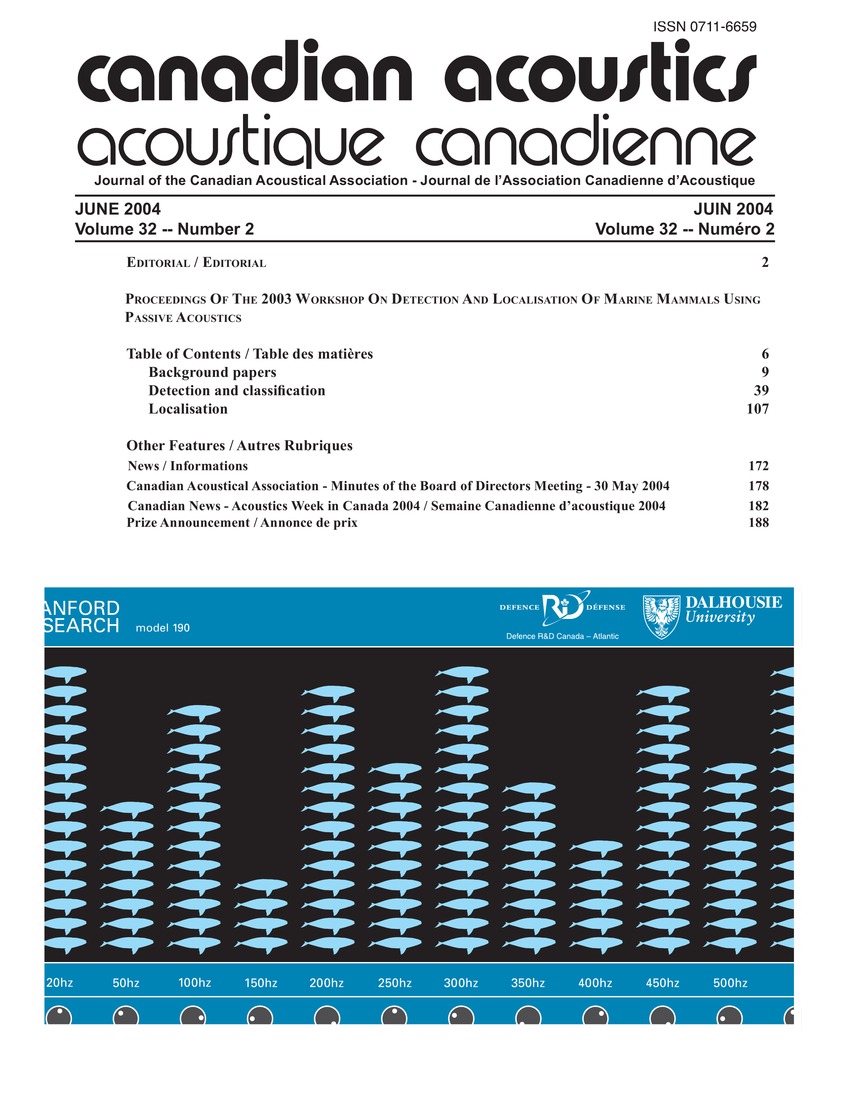Difar hydrophone usage in whale research
Mots-clés :
Antennas, Approximation theory, Error analysis, Hydrophones, Magnetic bearings, Sensors, Acoustics research, Bearing accuracy, Directional antennas, Whale researchRésumé
Les bouées acoustiques directionnelles DIFAR sont utilisées par la marine depuis plusieurs décennies, fournissant des relèvements magnétiques provenant d’un détecteur unique pour des sources sonores à basse fréquence (moins de 4 kHz). Les avancées computationnels ont fait de cette technologie un outil puissant et simple à utiliser. L’information présentée dans le présent article a pour but d’aider les nouveaux utilisateurs à déterminer quand les détecteurs DIFAR sont ou ne sont pas appropriés dans l’étude acoustique des baleines. La portée de détection acoustique pour baleines mysticètes atteint une moyenne voisine de 20 km mais varie de 5 à 100 km dépendant des conditions. La portée de la réception radio des bouées acoustiques à un navire de recherche typique atteint une moyenne d’environ 18 km avec une antenne omni directionnelle sur le bateau et une antenne standard sur la bouée acoustique. La précision du relèvement DIFAR est analysée pour un certain nombre de vocalisations de baleine où le parcours de la baleine est bien connu. Les relèvements provenant du détecteur DIFAR ont démontré une déviation standard de 2.1 degrés. Les erreurs systématiques et la déviation magnétique peuvent être corrigées en utilisant les relèvements DIFAR vers le son d’un navire de recherche qui a une position connue. Un réseau de détecteurs DIFAR a besoin de moins de détecteurs qu’un réseau d’hydrophones conventionnel et procure parfois une localisation de la source plus précise que la méthode hyperbolique des “temps d’arrivée” utilisée avec les hydrophones conventionnels. Les sons continus, comme ceux des bateaux, sont plus facile à localiser avec le détecteur DIFAR qu’avec les hydrophones conventionnels parce qu’il est souvent difficile de trouver des signaux transitoires permettant d’estimer les différences temporelles nécessaires pour le positionnement hyperbolique avec un réseau d’hydrophones conventionnel. Les systèmes d’hydrophones DIFAR conviennent aux vocalisations de baleines franches, bleues, de petits rorquals, rorquals communs et autres mysticètes, aussi bien qu’un bon nombre d’autres sons incluant les navires.Fichiers supplémentaires
Publié-e
Comment citer
Numéro
Rubrique
Licence
Author Licensing Addendum
This Licensing Addendum ("Addendum") is entered into between the undersigned Author(s) and Canadian Acoustics journal published by the Canadian Acoustical Association (hereinafter referred to as the "Publisher"). The Author(s) and the Publisher agree as follows:
-
Retained Rights: The Author(s) retain(s) the following rights:
- The right to reproduce, distribute, and publicly display the Work on the Author's personal website or the website of the Author's institution.
- The right to use the Work in the Author's teaching activities and presentations.
- The right to include the Work in a compilation for the Author's personal use, not for sale.
-
Grant of License: The Author(s) grant(s) to the Publisher a worldwide exclusive license to publish, reproduce, distribute, and display the Work in Canadian Acoustics and any other formats and media deemed appropriate by the Publisher.
-
Attribution: The Publisher agrees to include proper attribution to the Author(s) in all publications and reproductions of the Work.
-
No Conflict: This Addendum is intended to be in harmony with, and not in conflict with, the terms and conditions of the original agreement entered into between the Author(s) and the Publisher.
-
Copyright Clause: Copyright on articles is held by the Author(s). The corresponding Author has the right to grant on behalf of all Authors and does grant on behalf of all Authors, a worldwide exclusive license to the Publisher and its licensees in perpetuity, in all forms, formats, and media (whether known now or created in the future), including but not limited to the rights to publish, reproduce, distribute, display, store, translate, create adaptations, reprints, include within collections, and create summaries, extracts, and/or abstracts of the Contribution.


